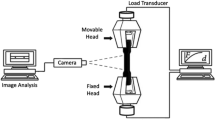Abstract
Earlier studies on photoplastic behaviour of polycarbonate are limited to the strain at which the localized yielding (necking) initiates (about 6% strain). In this study, the photoplastic behaviour of polycarbonate is studied using digital image correlation (DIC). Two cases are considered: one in which no localized yielding is observed and the other in which initiation and propagation of the localized yielding is observed. For the first case, a modified dog bone specimen is proposed to evaluate the photoplastic constant. In the second case, a conventional tensile test specimen is used. Both photoplasticity (transmission and reflection) and DIC experiments are performed on the specimens to determine the relation between fringe order and principal strain difference for strains of up to 60%. It is observed that the photoplastic constant is a function of strain. Finally, the behaviour of the tensile test specimen is numerically simulated. The true stress-strain curve of polycarbonate needed for FE simulation is determined using DIC experiments on the standard tensile test specimen. By post-processing the FE results, isochromatic fringes are plotted and compared with experimental results.


















Similar content being viewed by others
Notes
In reflection photoelasticity, as both the incident and the reflected light contribute to the photoplastic effect; a factor of 2 comes in the denominator of the right hand side of the equation (equation (1)). For transmission photoelasticity, the strain-optic law is same as equation (1) except for the factor of 2.
References
Javornicky J (1974) Photoplasticity. Elsevier Scientific, New York
Dally JW, Mulc A (1973) Polycarbonate as a model material for three dimensional photoplasticity. J Appl Mech 40(2):600–605
Ramesh K (2000) Digital photoelasticity: advanced techniques and applications. Springer Verlag, Berlin
Ramesh K (2008) Photoelasticity. In: Sharpe WN (ed) Springer handbook of experimental solid mechanics. Springer, New York, pp 701–742
Ramesh K, Kasimayan T, Neethi Simon B (2011) Digital Photoelasticity – a comprehensive review. J Strain Anal Eng Des 46(4):245–266
Herbert HF, Ohman L (1951) A study of elastic and plastic stress concentration factors due to notches and fillets in flat plates. NACA Tech. Rep., No. 1117
Frocht MM, Cheng YF (1963) An experimental study of the laws of double refraction in the plastic state in cellulose nitrate - Foundations for three-dimensional photoplasticity. In: Frocht MM (ed) Symposium on Photoelasticity. Pergamon Press, London, pp 195–216
Javornicky J (1968) Plastic stress and strain concentration factors in a strip with a hole or notches under tension. J Strain Anal 3:39–49
Halbert FB (1970) The ductile fracture of polycarbonate. Exp Mech 10(2):72–77
Halbert FB (1971) An interpretation of inelastic birefringence. Exp Mech 11(10):467–471
Takahashi S, Suetsugu M, Shimamoto A (1987) A basic study of plastic strain freezing by photoplastic experiment. JSME Int J 30(266):1237–1242
Wan X, Takahashi S (1989) A basic photoplastic experimentation on the stress-strain curves of polycarbonate resin. JSME Int J 32(3):391–395
Shimamoto A, Takahashi S (1990) Calibration of materials for Photoelastoplastic models. Exp Mech 30(2):114–119
Gutman GA, Jenkins WC, Tung TK (1965) Characterization of a birefringent material for use in Photoelasto-plasticity. Tech. Report, NASA-CR-57192
Whitfield JK, Smith CW (1972) Characterization studies of a potential photoelastoplastic material. Exp Mech 12(2):67–74
Ait El Ferrane MI, Lagarde A (1993) Photovisco-elastoplastic behavior of polycarbonate material under creep and tension tests. Exp Mech 33(2):148–152
Buisson G, Ravi-Chandar K (1990) On the constitutive behaviour of polycarbonate under large deformation. Polymer 31(11):207–2076
Sutton MA, Orteu JJ, Schreier HW (2009) Image correlation for shape, motion and deformation measurements. Springer, New York
Sutton MA, Wolters WJ, Peters WH, Ranson WF, McNeill R (1983) Determination of displacements using an improved digital correlation method. Exp Mech 1(3):133–139
Simon BN, Ramesh K (2010) A simple method to plot photoelastic fringes and phasemaps from finite element results. Journal of Aerospace Sciences & Technologies 62(3):174–182
Parsons E, Boyce MC, Parks MD (2004) An experimental investigation of the large-strain tensile behavior of neat and rubber-toughened polycarbonate. Polymer 45(8):2665–2684
G’Sell C, Hiver JM, Dahoun A (2002) Experimental characterization of deformation damage in solid polymers under tension, and its interrelation with necking. Int J Solids Struct 39:3857–3872
Lu J, Ravi-Chandar K (1999) Inelastic deformation and localization in polycarbonate under tension. Int J Solids Struct 36:391–425
Acknowledgements
The authors would like to acknowledge Sidharth Menon, Department of Mechanical Engineering, Amrita School of Engineering, Amritapuri, for his initial contribution on FE simulations.
Author information
Authors and Affiliations
Corresponding author
Rights and permissions
About this article
Cite this article
Subramanyam Reddy, M., Ramesh, K. Study of Photoplastic Behaviour of Polycarbonate using Digital Image Correlation. Exp Mech 58, 983–995 (2018). https://doi.org/10.1007/s11340-018-0399-y
Received:
Accepted:
Published:
Issue Date:
DOI: https://doi.org/10.1007/s11340-018-0399-y




